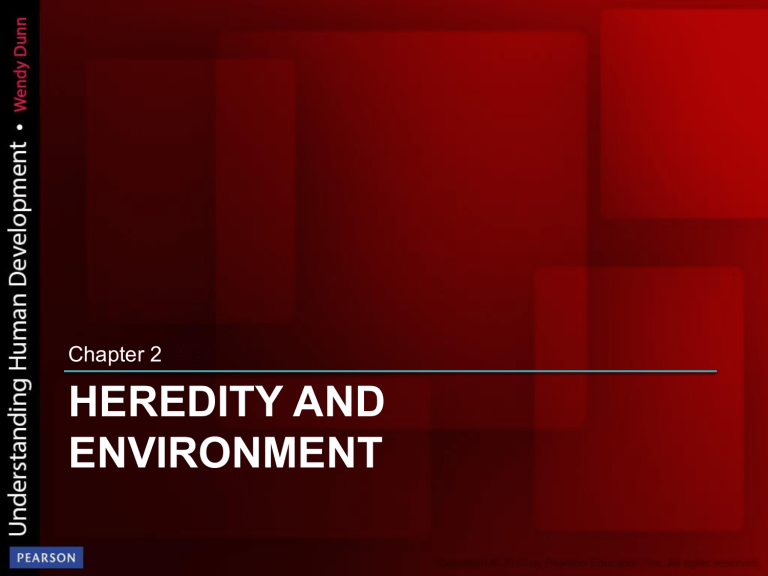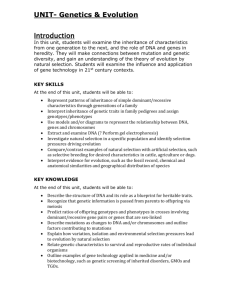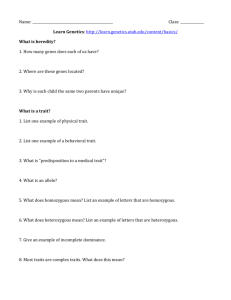heredity and environment

Chapter 2
HEREDITY AND
ENVIRONMENT
Heredity and Environment
Molecular Genetics
DNA is a complex molecule made up of nucleotides and four different bases
Bases form base pairs that should not vary
Basic units of inheritance are genesdelineated pieces of DNA
There are about 25,000 genes in human body
Major Features of a
Typical Cell
Computer-Generated Stimulation of
DNA Molecule
Note the twisted ladder-like structure, referred to as a double helix.
Base pairs form the rungs on the DNA ladder, (here in blue and purple), and their sequence determines the genetic traits that are carried in the DNA of each individual.
Segment of DNA Visualized as Ladder
How Can Such a Simple System
Dictate How Life Unfolds?
• Number of base pairs in
DNA molecule are very large
According to the Human Genome
Project, all humans are 99.9% genetically identical.
• Different species, and even different individuals within the same species, have different numbers of base pairs in their genome
• Order of pairing is important
What Is Protein Synthesis?
Most significant thing genes do is build proteins
Proteins are molecules that control life
Over 200,000 different proteins have been identified in humans
Common Proteins and Their Functions in the Human Body
Genes, Chromosomes, and Cell
Division
When cell divides, DNA assembles into chromosomes
Chromosomes are chains of genes that can be observed directly
All cells except sperm and egg cells contain 23 pairs of chromosomes
First 22 of those pairs are matching, and are referred to as autosomes
The 23rd pair determines sex selection and is labeled XX in females and XY in males
One ’s chromosomal makeup can be visualized in karyotypes
Human Karyotypes
Cell Division and Reproduction
Comparison of Mitosis and Meiosis
From Genotype to Phenotype
Genotype
• All of person’s pairs of alleles that form their genetic code
• Dominant allele
• Recessive allele
• Dominant trait expression
• Recessive trait expression
From Genotype to Phenotype
Simple dominance and recessive
• When an allele is dominant, its presence in gene pair has tendency to cause that trait to be expressed characteristic or trait
• Homozygous
• Heterozygous
Combination of genes
• Combinations of many gene pairs determine most traits
• Polygenetic inheritance
Examples of Dominant-Recessive
Gene Combinations
Genetic Inheritance
Polygenic human characteristics
• Determined by more than one gene pair
Sex-linked traits
• Usually passed on by
X chromosome
Hypothetically, the same parents can produce hundreds of trillions of unique children.
Genetic Inheritance
Genetic mutations
• May occur during mitosis or meiosis when
DNA molecule is altered during cell division
• May be beneficial or detrimental
Genetic and Chromosomal Disorders
Genetic anomalies
• Involve problems with instructional mechanism of genetic process
Sex-linked disorders
• Can occur when gametes do not replicate correctly or when genetic information, even entire chromosomes, are missing or duplicated
Crossing Over of Chromosomes
Sometimes during meiosis parts of chromosomes cross over, which creates new combinations of genes on a chromosome.
Source: Derived from Life (4th ed.), by R. Lewis, D. Gaffin, M.
Hoefnagels, and B. Parker,
2002, New York: McGraw-Hill.
Gene-Environment Interactions:
The Study of Epigenetics
Individuals differ not only in their genes, but also in specific ways in which they experience their environments
Environmental forces can change gene expressions
Epigenetic modifications may be transmitted to next generation via genetic inheritance
Gene-environment interactions occur at many levels
Experience in life can have dramatic effect on later developmental outcomes
Some Sex-Linked Disorders
Autosomal Disorders
Genetic Research
Genetic research
• Uses recombinant
DNA technology to reconstruct cells and genes
Gene therapies
• Involve reinserting geneticallyaltered cells into a person
In vivo gene therapy
• Removes some viral genes, inserts cloned normal genes and reintroduces retrovirus to patient
Video Clip
Description of different types of genetic testing: http://www.youtube.com/watch?v=dJuo937gz44
Video Clip
BBC documentary on Designer Babies with commentary by Princeton professor Lee
Silver: http://www.youtube.com/watch?v=TN9ep4B9Hw0& feature=PlayList&p=C7E239A945F4C4BA&playne xt=1&playnext_from=PL&index=56
Behavior Genetics
Tries to understand the genetic origins of behaviors
Incorporates the view that complex traits are determined by interaction of heredity and environment
Looks at statistical correlation, or concordance, of similar characteristics with genes
What is a concordance rate?
Let’s find out.
Behavior Genetics
Concordance rates form the basis of estimates of heritability, the proportion of a trait that is thought to result from genetic factors.
How are these estimates determined?
Behavior Genetics Studies
Environmental Influences and Contexts
Basic
Processes that Affect
Behavior
• Habituation
• Classical
Conditioning
• Operant
Conditioning
• Social
Learning
A Typical Classical Conditioning
Procedure
Operant Conditioning
Reinforcers increase the likelihood that a behavior will be repeated
Punishments decrease the probability that a behavior will be repeated
Applied Behavior Analysis
Applied behavior analysis
Application of learning principles to change behavior
Sometimes called behavior modification
Family and Culture
Family systems are at heart of human behavior
Families pay critical role in orienting people to society and culture
Siblings share many similar experiences, but nonshared experiences and relationships also exist
Stop and Think!
Your textbook suggests it is important to avoid ethnocentrism.
Do you agree? Why? Why not?
Sociocultural Influences
Cultural factors affect a cohort, a group of individuals born during the same historical era.
How would you describe YOUR cohort?
Sociocultural Influences
Types of cultural influences
Normative age-graded: biological and social changes
Normative history-graded: historical events such as wars, depressions, and epidemics
Non-normative: individual factors such as divorce, unemployment, illness, career changes
A Lifespan Profile on Influences
Development in a Broad Context








